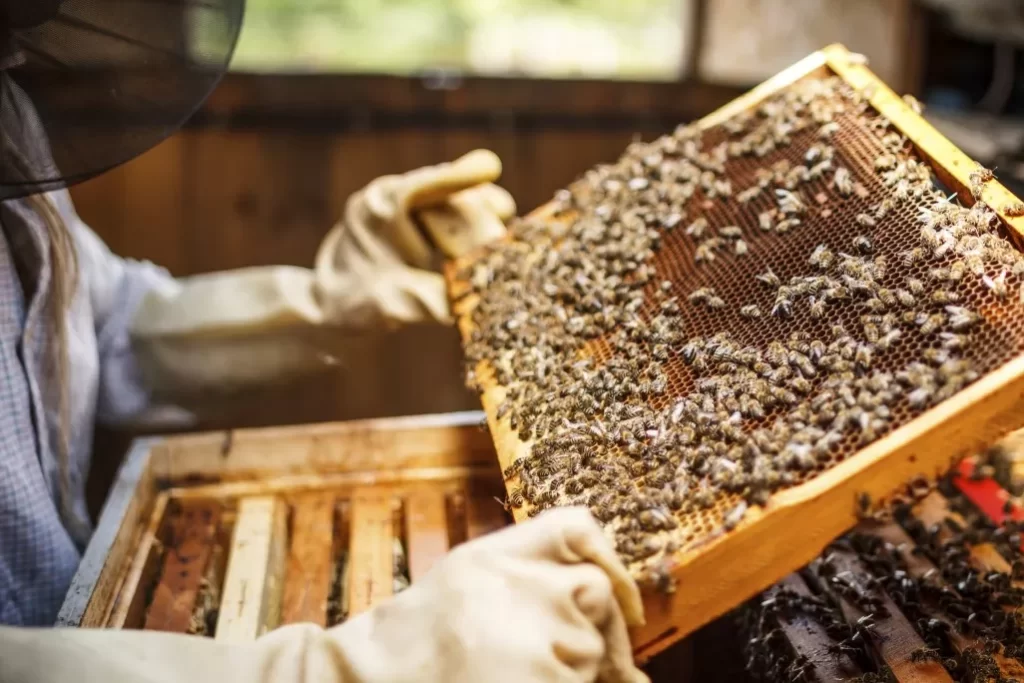In April, bees are in full swing. There will still be some cold snaps, especially in early April, but the weather over the past two weeks has been very favorable for the rapid expansion of bees and even the introduction of more and more nectar and pollen.
The strongest nectar flow begins in the third week of April and usually lasts for about two months. The Queen Bee is now safe and sound. The hive is rapidly expanding. Early spring, early flowering trees and shrubs are vital for bees.
Keep Feeding
Feeding helps the bees build up. No supers are on your hive yet, so their sugar intake doesn’t make it into your honey product. They are only fed to give the hive a head start. Put the pollen cake on top as well. April can be cold and wet, which means your bees may have limited opportunities to fly out and forage.
Therefore, you need to keep checking the hive to make sure it has an adequate supply of food. When a significant amount of brood is being laid, which happens through May, bees are constantly looking for water and pollen; both are necessary for a healthy brood. You can see bees sucking water out of potted plants or puddles and pulling trace elements out of “dirty” water as they do.

Read more: Feeding Bees In Winter
April Beekeeper Tasks
A majority of packages will be installed during the month of April. Make sure you familiarize yourself with (or re-familiarize yourself with) the requirements of the starter pack and take enough steps to ensure its success.
Once your bees stop eating sugar feeds, stop feeding bees and put supers on, as bees are now collecting nectar from a growing number of sources; early flowering plants and trees like maples, locusts, etc.
If your colony doesn’t survive, make sure your hive is ready for your new bees, which could arrive at any time.
Install bees in brand new hives.
This is a good time to start balancing your hives. You may need to combine weak hives with strong hives. Despite knowing better, every year some beekeepers seem to be too sympathetic to their struggling hives and try to restore them to health. While some achievements can be obtained, they are usually not worth it. Spending too much time on a struggling hive is costly.
If you have mice in your hive, we recommend rinsing the empty hive with diluted bleach and letting it air dry completely before putting anything back
If your colonies survive, continue feeding the 1:1 water-sugar solution until you see flowers bloom. It’s always good to plant an early blooming flower near your bees to give them an early start to spring
If your colony survives but the queen is struggling, consider replacing the queen bee.
Bees Swarm In April
You will need to implement a crowd management strategy. Remember, bees breed in swarms. This is not a sign of a bad beekeeper. Some important steps must be taken to prevent the swarms. Remember that you need to give the hive room to expand.
Put on as many supers of drawn comb as you’d like. Some experts believe that it is a good practice to have at least two extracted honey supers on all hives during the nectar season. Three or four Supers is better. Don’t wait to add your Supers or you may miss some Nectar Flows. Get all Supers by April 1st!
Consider keeping extra empty beehives on hand so you can catch swarms. You’ll want to capture your own colony, or you’ll likely get a call once your neighbor finds out you’re a beekeeper. Some beekeepers receive multiple calls per week throughout the spring and summer.
Pests, Parasites, And Diseases
Begin monthly monitoring for Varroa mites. If you find two or more mites (per 100 bees) in sugar shakes, ether rolls, or alcohol rinses at this time of year, consider treating them. Treatment depends on your management goals, colony status, and external conditions. This is an ideal time for healing that isn’t available when using superpowers.
If rearing drones in large numbers, you can use a drone comb for early Varroa management, but be sure to return within at least 28 days to ensure it doesn’t become a haven for mites!
Carefully inspect each brood frame in each colony for American foulbrood infection.
Removing dead bees and debris from the floor during the first thorough inspection helps keep hive diseases and infestations harmless.
Beekeeper Reading List
Here are a few books that might help you! !
Buzz: The Nature and Necessity of Bees by Thor Hanson
Honeybee Democracy by Thomas D. Seeley
Dancing With Bees: A Journey Back to Nature by Brigit Strawbridge Howard
Our Native Bees by Paige Embry

